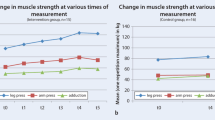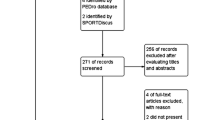Abstract
Approaches to and benefits from resistance training for non-compromised older adults are well known. Less is understood about resistance training with pre-frail older adults, and even less information is available on the practical approaches to delivery. Herein, we describe an approach in pre-frail females who undertook a multi-component exercise intervention, inclusive of high-intensity, free-weight, functional resistance training. Capitalizing on the principle of overload is possible and safe for pre-frail females through constant reassurance of ability and adjustments in technique. Making exercise functionally relevant, for example, a squat is the ability to get on and off a toilet, resonates meaning. Older pre-frail females are affected by outside (clinical) influences. The exercise participant, and extraneous persons need to be educated on exercise approaches, to increase awareness, debunk myths, and enhance support for participation. Identification of individuality in a group session offers ability to navigate barriers for successful implementation.


Similar content being viewed by others
References
Bray NW, Jones GR, Rush KL, Jones CA, Jakobi JM. Multi-component exercise with high-intensity, free-weight, functional resistance-training in pre-frail females: A quasiexperimental, pilot study. J Frailty Aging 2019;In Press.
Puts MTE, Toubasi S, Andrew MK, et al. Interventions to prevent or reduce the level of frailty in community-dwelling older adults: A scoping review of the literature and international policies. Age Ageing 2017;46(3):383–392.
Watson SL, Weeks BK, Weis LJ, Horan SA, Beck BR. Heavy resistance training is safe and improves bone, function, and stature in postmenopausal women with low to very low bone mass: novel early findings from the LIFTMOR trial. Osteoporos Int 2015;26(12):2889–94.
Hicks GE, Shardell M, Alley DE, et al. Absolute strength and loss of strength as predictors of mobility decline in older adults: The InCHIANTI study. J Gerontol A Biol Sci Med Sci 2012;67(1):66–73.
Bandeen-Roche K, Seplaki CL, Huang J, et al. Frailty in Older Adults: A Nationally Representative Profile in the United States. J Gerontol A Biol Sci Med Sci 2015;70(11):1427–34.
Bray NW, Doherty TJ, Montero-Odasso M. The Effect of High Dose Vitamin D3 on Physical Performance in Frail Older Adults. A Feasibility Study. J Frailty Aging 2018;7(3):155–61.
Theou O, Stathokostas L, Roland KP, et al. The effectiveness of exercise interventions for the management of frailty: a systematic review. J Aging Res 2011;2011:569194.
Jones GR, Jakobi JM. Launching a new initiative. Appl Physiol Nutr Metab 2017;42(9):iii–iv.
Bray NW, Smart RR, Jakobi JM, Jones GR. Exercise prescription to reverse frailty. Appl Physiol Nutr Metab 2016;41(10):1112–16.
Riebe D, Ehrman JK, Liguori G, et al. ACSM’s Guidelines for Exercise Testing and Prescription. 10th ed. Baltimore (MD): Lippincott Williams & Wilkins; 2018. 249–257 p.
Gearhart RF, Lagally KM, Riechman SE, et al. Strength Tracking Using the OMNI Resistance Exercise Scale in Older Men and Women. J Strength Cond Res 2009;23(3):1011–5.
Zourdos MC, Klemp A, Dolan C, et al. Novel Resistance Training-Specific Rating of Perceived Exertion Scale Measuring Repetitions in Reserve. J Strength Cond Res 2016;30(1):267–75.
Beauchamp MR, Eys M. Group dynamics in exercise and sport psychology. New York, NY: Routledge, 2014.
Testa M, Noakes TD, Desgorces F-D. Training state improves the relationship between rating of perceived exertion and relative exercise volume during resistance exercises. J Strength Cond Res 2012;26(11):2990–6.
Theou O, Brothers TD, Peña FG, et al. Identifying common characteristics of frailty across seven scales. J Am Geriatr Soc 2014;62(5):901–6.
Acknowledgement
We wish to acknowledge the support from Flaman Fitness™ and the Okanagan Men’s Shed Club for generously donating the exercise equipment, graduate students (Rowan Smart and Sam Kuzyk) and senior undergraduate students (Anup Dhaliwal, Brett Yungen, Savannah Frederick, Paul Cotton and Cydney Richardson), and all the participants involved in this study.
Author information
Authors and Affiliations
Corresponding author
Additional information
Funding
Partial funding for this study through the Canadian Institutes for Health Research (CIHR) Grant # 385692. The sponsors had no role in the design and conduct of the study; in the collection, analysis, and interpretation of data; in the preparation of the manuscript; or in the review or approval of the manuscript.
Ethics approval and consent
All participants read and signed a letter of informed consent. Ethical approval was granted by the institutional Research Ethics Board (H16-00712).
Availability of the data and materials
The original data and materials are available through the institutions open access graduate thesis repository https://open.library.ubc.ca/cIRcle/ collections/ubctheses/24/items/1.0353165
Competing interests
None
Trial Registration
This study was prospectively registered with ClincalTrials.gov (NCT02952443) on October 31, 2016.
Rights and permissions
About this article
Cite this article
Bray, N., Jones, G., Rush, K. et al. Practical Implications for Strength and Conditioning of Older Pre-Frail Females. J Frailty Aging 9, 118–121 (2020). https://doi.org/10.14283/jfa.2020.15
Received:
Accepted:
Published:
Issue Date:
DOI: https://doi.org/10.14283/jfa.2020.15




